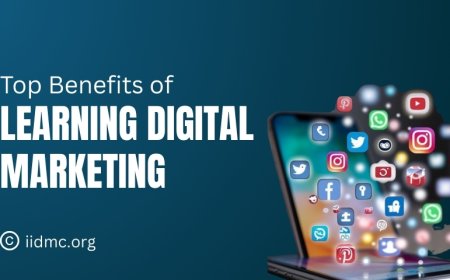Top Google Ads Tips for Success
Discover top Google Ads tips for success and learn how to optimize your campaigns, increase ROI, and achieve your marketing goals with actionable strategies.

In today's competitive digital landscape, mastering Google Ads is essential for businesses looking to maximize their online presence and improve meaningful results. With billions of searches happening every day, Google Ads offers an unparalleled opportunity to reach potential customers at the exact moment they're searching for products or services like yours. However, running a successful campaign requires more than just setting up ads it demands a strategic approach. In this blog, we’ll dive into the top Google Ads tips that can help you optimize your campaigns, boost your ROI, and achieve long-term success. Whether you're a beginner or a seasoned marketer, these insights will give you the edge you need to stand out and succeed.
Start with Clear Goals for Google Ads Success
Setting specific, measurable goals is key to a successful Google Ads campaign. Whether you're aiming to increase website traffic, generate leads, or drive sales, clear objectives guide every decision.
Why Clear Goals Matter:
-
Track Performance: Measurable goals let you monitor success and optimize campaigns.
-
Optimize Strategy: Goals help you make data-driven adjustments.
-
Justify Spend: Defined objectives tie results to ad spend.
Examples of Campaign Goals:
-
Website Traffic: Focus on high-volume keywords and engaging ad copy.
-
Lead Generation: Use strong CTAs and optimize for conversions.
-
Driving Sales: Target purchase-ready users with tailored ads.
How Goals Shape Campaign Structure:
-
Ad Groups & Keywords: Goals dictate which keywords and ad copy to use.
-
Bidding Strategies: Traffic goals need click-maximization, sales need ROAS or CPA targeting.
-
Ad Formats: Match ad types—search, display, or shopping—to your specific objectives.
Clear goals ensure focused campaigns that deliver results.
Use the Right Keywords for Effective Google Ads
Choosing the right keywords is crucial to reaching your target audience in Google Ads. Proper keyword research ensures your ads appear in front of people actively searching for your products or services.
Importance of Keyword Research
-
Target the Right Audience: The right keywords connect you with potential customers at different stages of the buying journey.
-
Maximize Ad Spend: Well-chosen keywords help avoid wasted clicks, ensuring your budget is spent on users with high intent.
Keyword Research Tools:
-
Google Keyword Planner: Ideal for discovering keyword volume and trends.
-
SEMrush & Ahrefs: Offer deeper insights, including competitor keyword data.
Keyword Match Types:
-
Broad Match: Reaches the largest audience but can be less relevant.
-
Phrase Match: Triggers ads for specific phrases with flexibility.
-
Exact Match: Shows ads for precise keywords, giving you tight control.
-
Negative Keywords: Exclude irrelevant searches to avoid wasted spend.
Tip: Avoid Broad Match Mistakes
Use negative keywords to filter out irrelevant traffic and save your budget by avoiding overly broad targeting. Focus on specific keywords for more precise targeting and better results.
Optimize Your Ad Copy for Better Google Ads Performance
Writing compelling ad copy that matches user intent is key to attracting clicks and driving conversions in Google Ads. High-quality, relevant ads will resonate with your audience and encourage action.
Crafting Effective Ad Copy:
-
Match User Intent: Ensure your ad copy aligns with what users are searching for, addressing their needs or problems directly.
-
Strong CTAs: Use clear calls-to-action like “Shop Now” or “Get a Free Quote” to prompt immediate action.
-
Highlight USPs: Emphasize what sets you apart from competitors, such as free shipping, special discounts, or exclusive products.
A/B Testing for Continuous Improvement:
Regularly A/B test different versions of your ad copy to see which performs better. Test elements like headlines, CTAs, and USPs to optimize click-through and conversion rates.
Boost Performance with Ad Extensions:
-
Callouts & Sitelinks: Add extra info or direct users to specific pages.
-
Reviews & Ratings: Build trust with social proof.
-
Location & Call Extensions: Make it easier for users to contact or find you.
Well-optimized ad copy, supported by the right ad extensions, improves click-through rates and ensures your ads perform at their best.
Leverage Ad Extensions to Boost Google Ads Performance
Ad extensions are crucial tools that enhance your ads by providing extra information, making them more appealing and useful to potential customers. They not only improve your ad’s visibility but also increase click-through rates (CTR), giving your campaigns a performance edge.
Why Ad Extensions Matter:
Ad extensions make your ads more engaging by offering additional links, contact info, or special offers. They take up more screen space, making your ad more prominent and improving CTR. Plus, they provide users with quick access to the information they need, increasing the chances of conversions.
Types of Ad Extensions:
-
Sitelink Extensions: Direct users to specific pages like product categories or promotions.
-
Call Extensions: Add your phone number, allowing mobile users to call directly from the ad.
-
Location Extensions: Show your business address, helping users find your physical store.
-
Price Extensions: Display the price of your services or products, enticing users with clear offers.
Choosing the Right Extension:
-
For Lead Generation: Use call and form extensions to make contact easy.
-
For E-commerce: Price and sitelink extensions can showcase deals or product categories.
-
For Local Businesses: Location and call extensions help drive foot traffic and phone inquiries.
How Extensions Increase Visibility and CTR:
Ad extensions add extra content to your ads, making them larger and more noticeable. They provide multiple ways for users to interact, increasing the likelihood of clicks and improving overall ad performance.
Incorporating the right ad extensions can significantly improve your campaign's effectiveness and drive better results for your business.
Focus on Landing Page Optimization for Better Google Ads Results
A well-optimized landing page is crucial for converting clicks into customers. Aligning your ad copy with the landing page ensures a seamless user experience, which directly impacts your campaign's success.
Align Ad Copy with Landing Pages
Ensure the messaging in your ads matches the content on your landing page. If users click on an ad promising “50% off,” they should land on a page that clearly highlights that offer. This consistency builds trust and keeps users engaged.
Key Elements of a High-Converting Landing Page:

-
Relevance: The page content must directly match the user’s search intent and the promise in your ad.
-
Load Speed: Fast-loading pages prevent users from leaving due to frustration, helping to retain potential customers.
-
Mobile-Friendliness: Ensure the page is fully responsive and easy to navigate on mobile devices.
-
Clear CTA: A strong, easily visible call-to-action (e.g., “Buy Now” or “Sign Up”) guides users towards conversion.
Reducing Bounce Rates & Improving Quality Score:
-
Page Experience: A well-designed page with easy navigation and relevant content keeps users from bouncing, leading to higher engagement.
-
Quality Score: Google rewards high-quality landing pages with better ad placement and lower costs. By improving relevance and user experience, you enhance both Quality Score and campaign performance.
Optimizing your landing pages improves conversion rates, reduces bounce rates, and boosts your overall Google Ads effectiveness.
Use Smart Bidding Strategies to Optimize Google Ads Performance
Automated bidding strategies, also known as smart bidding, allow Google Ads to optimize your bids based on the likelihood of conversions. This can improve your ROI by taking advantage of machine learning to adjust bids in real-time.
Automated Bidding Strategies:
-
Maximize Conversions: Automatically sets bids to get the most conversions within your budget.
-
Target CPA (Cost Per Acquisition): Aims to achieve the most conversions at your target cost per acquisition.
-
Target ROAS (Return on Ad Spend): Adjusts bids to maximize revenue based on your desired return on ad spend.
Manual vs. Automated Bidding:
-
Manual Bidding: Best for those who want full control over their bids and budget adjustments, especially in niche or low-budget campaigns.
-
Automated Bidding: Ideal for larger campaigns or when you want to maximize efficiency without constant manual adjustments.
Best Practices for Smart Bidding:
-
Set clear, measurable goals (conversions, revenue, etc.).
-
Give smart bidding enough time and data to optimize fully.
-
Continuously monitor and refine goals as your campaign progresses to maximize ROI.
Monitor and Optimize Quality Score to Lower Costs
Your Quality Score in Google Ads plays a significant role in determining your ad rank and cost-per-click (CPC). Higher Quality Scores lead to lower costs and better ad placement.
Factors That Influence Quality Score:
-
Ad Relevance: Ensure your ad copy closely matches user search queries.
-
Click-Through Rate (CTR): A higher CTR indicates that users find your ad appealing and relevant.
-
Landing Page Experience: Ensure that your landing page is fast, mobile-friendly, and directly related to the ad content.
How to Improve Your Quality Score:
-
Align your keywords, ad copy, and landing page content.
-
Improve CTR by testing different ad copy and adding compelling CTAs.
-
Optimize landing pages for speed, mobile-friendliness, and relevance to the ad.
By improving your Quality Score, you can lower your CPC, improve ad rank, and enhance the overall effectiveness of your Google Ads campaigns.
Track and Analyze Your Campaign Data for Success
Tracking performance metrics is essential for understanding how your Google Ads campaigns are performing and for making data-driven adjustments.
Key Metrics to Track:
-
Impressions: The number of times your ad is shown.
-
Clicks: How often users click on your ad.
-
Conversions: Actions that meet your campaign goals, such as purchases or sign-ups.
-
Cost-Per-Click (CPC): The amount you pay for each click.
Set Up Google Analytics and Conversion Tracking:
Integrate Google Analytics and conversion tracking to gain deeper insights into user behavior and track important actions like form submissions or sales.
Use Custom Reports:
Custom reports in Google Ads and Google Analytics allow you to monitor key metrics, spot trends, and quickly identify areas needing improvement.
Retarget Your Audience to Re-Engage Potential Customers
Retargeting (remarketing) lets you show ads to users who have previously interacted with your site, increasing your chances of conversion.
How Retargeting Works:
It allows you to re-engage visitors who didn’t convert the first time by showing them relevant ads as they browse other websites or use Google search.
Strategies for Remarketing Campaigns:
-
Display Network: Show visually engaging ads to users across Google’s Display Network.
-
Remarketing Lists for Search Ads (RLSAs): Target previous visitors with tailored search ads when they search again on Google.
Best Practices for Retargeting:
-
Frequency Capping: Limit how often ads are shown to avoid overwhelming users.
-
Exclude Converted Users: Don’t waste budget on users who have already completed your desired action.
Regularly Test and Optimize Your Campaigns
Continuous testing and optimization are crucial for improving the performance of your campaigns over time.
Examples of Tests:
-
Ad Copy: Test different headlines, descriptions, and CTAs to see which version performs better.
-
Bidding Strategies: Experiment with automated vs. manual bidding to find the most cost-effective approach.
-
Targeting: Adjust audience targeting or keyword match types to improve relevancy.
-
Ad Formats: Test search ads, display ads, and shopping ads to see what works best for your goals.
Implementing Changes:
Use insights from tests to make gradual improvements, refining your ads, keywords, and landing pages based on what drives the best results. Continuous optimization is key to long-term success.
Applying these Google Ads strategies—setting clear goals, conducting proper keyword research, optimizing your ad copy, and leveraging ad extensions can greatly enhance your campaign performance. Tracking and analyzing your data, retargeting potential customers, and continuously testing and optimizing your campaigns are essential steps for achieving long-term success in Google Ads.
Remember, success in Google Ads is not a one-time effort but an ongoing process of refinement. Be sure to regularly test and adjust your strategies for better results. If you're looking to improve your campaigns, we invite you to take advantage of a free Google Ads audit from IIDMC or share your own tips in the comments below.





























